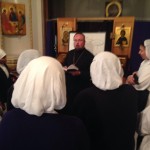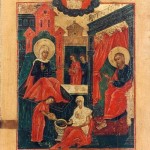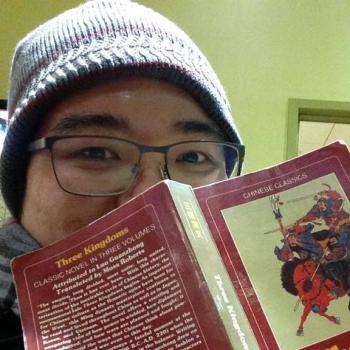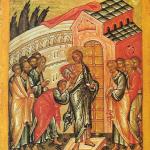![Theotokos of Vyshhorod, more popularly known as Theotokos of Vladimir (Vladimirskaya-1.jpg) [PD-US], via Wikimedia Commons](https://wp-media.patheos.com/blogs/sites/721/2016/08/Vladimirskaya-1.jpg)
On this Nativity of Our Lady, the Theotokos and Ever-Virgin, I want to wish my ‘Mom’ a happy birthday, but I’d like to also work through why I’ll continue to call her my ‘Mom.’ Indeed, I want to kiss her as Christ does in the Eleusa Icon, the image of Tenderness and Sweet-Kissing as the Christ-child nuzzles against the face of his Mother, most famously in the Theotokos of Vyshhorod, which is more popularly known as the Theotokos of Vladimir.
I’ve been mulling over a passage in St Symeon the New Theologian’s first Ethical Discourse where he discusses how the Most Holy Theotokos is indeed our Mother:
Just as we all receive of His fulness, so do we all partake of the immaculate flesh of His all-holy Mother which He assumed, and so, just as Christ our God, true God, became her son; even so we too – O, the ineffable love for mankind! – become sons of His mother, the Theotokos, and brothers of Christ Himself, as through the all-immaculate and ineffable marriage which took place with and in her, the Son of God was born of her and from Him in turn, all the saints. (First Ethical Discourse IX, p. 59)
Symeon then ties this to the Eucharist:
According to this reasoning, therefore, the mother of God is lady and Queen and mistress and mother of all the saints. The saints are all both her servants, since she is the mother of God, and her sons, because they partake of the all-pure flesh of her Son – here is a word worthy of belief [1 Tim 1:15], since the flesh of the Lord is the flesh of the Theotokos – and by communing in this same deified flesh of the Lord, we both confess and believe that we partake of life everlasting, provided, of course, that we do not do so unworthily, in which case we do it to our own condemnation. The saints therefore are triply her kin: first, in that they are related to her from the same clay and breath of life [given Adam]; secondly, that they have communion and share with her in the flesh which was taken from her; thirdly and last, that on account of the hallowing which has come to pass in them through her by virtue of the Spirit, each conceives in like manner to her within himself the God of all, as she bore Him in herself. For, if indeed she gave birth to Him in the body, yet she always possessed all of Him in the Spirit, and has Him now, and will ever have Him inseparable from her. (First Ethical Discourse IX, p. 60)
Partaking of Holy Communion, sharing in the flesh of the Lord and the Theotokos, bearing G-d in our body: these are acts of intimacy. Our adoption as co-heirs with Christ gives us a Mother, our ‘Jerusalem from above,’ as St Paul puts it in his letter to the church in Galatia (4.26). If that is who she is to me, then why not call her ‘Mom’? If the Lord can call his Father ‘Abba,’ then can I not use informal language as an act of pure love?
I suspect what perhaps makes some people antsy about the informalities of intimacy is that they remind them of what sociologist Donald Miller calls the ‘therapeutic, individualistic, anti-establishmentarian’ character of contemporary American evangelicalism. A friend once said to me as I was en route from Anglicanism to Catholicism that because I was not yet Catholic, I was a most interesting Catholic because I was in fact an evangelical, but once I’d become Catholic, I’d make a most interesting evangelical. Neither of us anticipated then that I’d enter the Catholic communion through an Eastern Catholic church, and since my friend is Latin, I expect that he’ll never forgive me for it. But since we are on the subject, I suppose that he might actually be right – that perhaps it will be impossible for me to shake my former evangelical, charismatic, and Anglican sensibilities as an Eastern Catholic. I grew up with a worship that was informal and intimate; if my supernatural sensibilities remain informal and intimate, it probably has something to do with that.
But maybe the question is whether I need to shake that intimate informality. One of the things that was emphasized to me during my catechumenate is that the ideal Eastern Catholic temple is a perfect place to bring your kids precisely because there’s so much fun to be had: they can sleep on the floor, crawl and run around, kiss icons on the walls, and light candles – which means that the best part of church is supposed to be that children are allowed to play with fire. This is where the debate about pews in Eastern Catholic circles comes most squarely into view. One who has spent any time among Eastern Catholics discovers that one of the most hotly debated topics is whether or not temples should remove their pews, so much so that the discussion boards online joke about them on good days and complain about how superficial this topic is on bad days. The perception here, of course, is that the ‘no pews’ people are the hardass traditionalists who want people standing through the whole service as a way of nostalgically recovering some kind of ‘authentic’ Byzantine liturgical sensibility.
But authenticity is not what Bishop Kallistos Ware is thinking about when he complains about pews:
It is a remarkable thing how great a difference the presence or absence of pews can make to the whole spirit of Christian worship. There is in Orthodox worship a flexibility, an unself-conscious informality, not found among western congregations, at ay rate north of the Alps. Western worshippers, ranged in their neat rows, all in their proper places, cannot move about during the service without causing a disturbance; a western congregation is generally expected to arrive at the beginning and to stay to the end. But in Orthodox worship people can come and go far more freely, and nobody is greatly surprised if they move about during the service. The same informality and freedom also characterizes the behaviour of the clergy: ceremonial movements are not so minutely prescribed as in the west, priestly gestures are less stylized and more natural. This informality, while it can lead at times to irreverence, is in the end a precious quality which Orthodox would be most sorry to lose. They are at home in their church – not troops on a parade ground, but children in their Father’s house. Orthodox worship is often termed ‘otherworldly’, but could more truly be described as ‘homely’: it is a family affair. Yet behind this homeliness and informality there lies a deep sense of mystery. (Ware, The Orthodox Church, p. 262-3, bold emphasis mine.)
In other words, the whole point of Byzantine worship has seemed to me both in experience and in my reading to simply be about being a child in my Father’s house. It’s informal, tender, childlike. It’s a place where when I enter and see the icon of the Theotokos on the iconostas, and when we are ‘remembering our most pure Lady, the Theotokos and Ever-Virgin’ during the litanies, I reverence her simply because my heart overflows with love for my Mom.
Yes, as St Symeon himself says, the Most Holy Theotokos is our Queen. But when I see the icon of the Theotokos of Częstochowa, I don’t see the Queen of Poland, partly because I am not Polish; instead, I am drawn in by her eyes as she shows me the way to Christ, and like my student Eugenia, I run to her. When I behold the Theotokos of Vladimir, I may be aware of her importance in Russian imperial history, but perhaps it is because I am not Russian that what I see is the child sweetly kissing his Mother. I am aware that my church’s catechism says that these two icons are in fact of Kyivan provenance, but it is perhaps because I am not Ukrainian that all I see is the face of pure love in my Mom. To kiss my Mom is neither to belong to a nation nor to lend my support to a state; if anything, it is to recognize the pervasiveness of her maternal care that transcends nations, states, and identities.
So it is with a heart bursting with love that I join the Christ child in the icon of the Theotokos of Vyshhorod/Vladimir to kiss my Mom and wish her a happy birthday.
POSTSCRIPT: It has come to my attention that today is the day for venerating the Theotokos of Vyshhorod on the Old Calendar. That the inspiration for this post came from this icon means that the Holy Spirit is at work in all of us on both the Old and New Calendars.
















